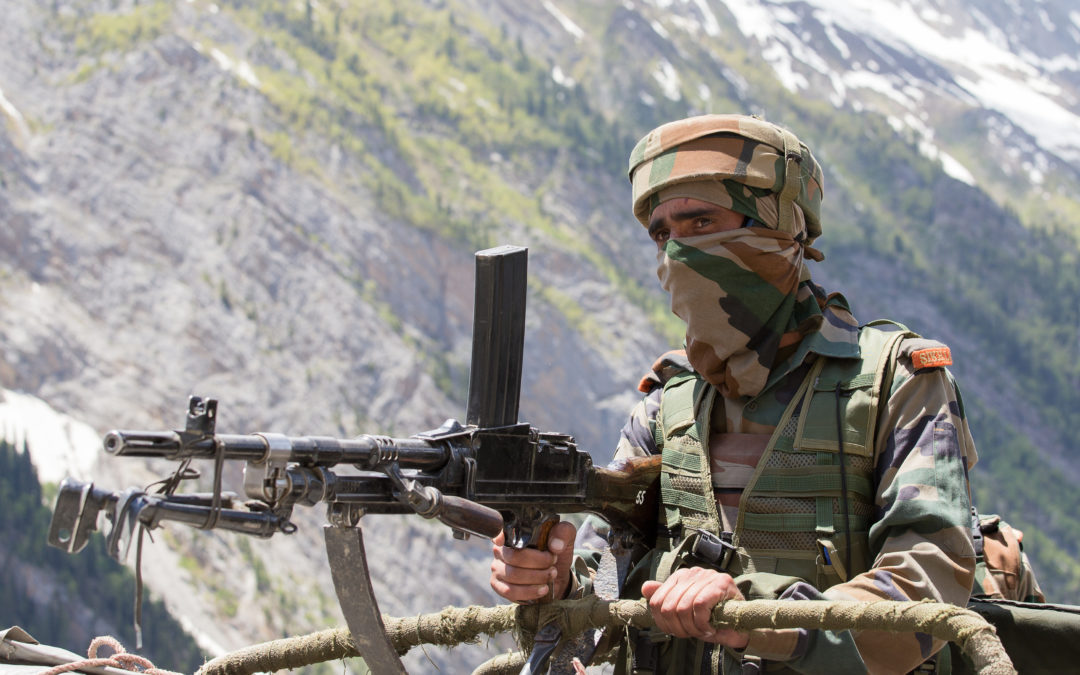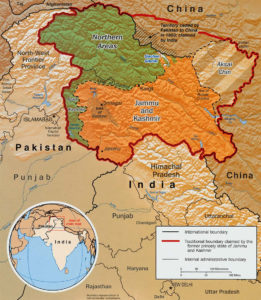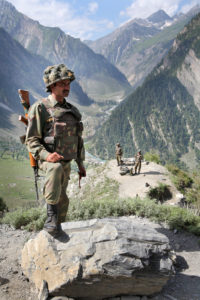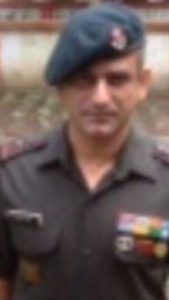
Security 101: In The Line Of Fire, Plan, Prepare, Persevere
An Indian soldier on the India-Pakistan Line of Control in Kashmir. Picture © Oleg Doroshenko | Dreamstime.com
For far too long, too many soldiers, paramilitary forces, and other security personnel have died because of a lack of planning or foresight. While there are any number of things beyond a commander’s control, there are details they need to keep in mind from their end too, to avoid what they can of the casualties of war.
Leadership isn’t easy in any case, but for military commanders sworn to protect their countries, there’s another heavy responsibility — that of sending those that serve under them into battle. Here’s a glimpse of what goes into giving those that serve every advantage they can get, especially in hostile territory.
By Sushil Kumar Singh
Lokut Bangas sits right on the always fraught India-Pakistan border, about seven miles from the town of Khanbal, in the Indian state of Jammu & Kashmir’s Kupwara district. It is about 10 miles from Naugam sector, also close to the disputed India-Pakistan Line of Control in the Kashmir Valley. It is a line that is not a recognized international boundary, but a border between two hostile neighbors, for all practical purposes. In a not-so-distant past, Lokut Bangas (which means “small valley” in Kashmiri) also used to be a major infiltration route for militants from across the border.
In 2003, I was posted in Delhi during a fidayeen attack in Lokut Bangas, in which an Indian Army battalion (not mine, but we had several in the area) lost seven men. The fidayeen of South Asia, also referred to as fedayeen in the Middle East, are small bands of highly trained men, specializing in guerrilla warfare, trained to inflict maximum damage on a specific target before they are (typically) taken out. In this case, the target was a company-occupied post, a post that, we later knew with the luxury of hindsight, had been poorly sited. That company post, incidentally, was vacated after this particular attack.
But the problem remained. Three years later, in 2006, I was tasked to set up base there again and begin what we called “seek and destroy” missions, to plug infiltration gaps within the area my particular company had charge of. Militants in The Valley (Kashmir) had begun to frequent the area for infiltration into Indian territory.
Listen, Ask, See

Like most unit commanders going into battle, I spent some time thinking about my mission, specifically taking the time to learn about the history of the area, to anticipate any roadblocks. You can’t always foresee everything, but it would be foolish and counter-productive to go into what is known hostile territory, even on your side of that metaphorical red line, without getting all the information you possibly can.
I also spoke to a batch mate who happened to be in the battalion that had lost those men in the 2003 attack, and after several more conversations with people familiar with the area, and a detailed briefing of my men, we moved into location in the dead of night.
I visited the above-mentioned campsite, which had once been an ill-fated company post. God bless those souls, but they were sitting ducks. Quite frankly, even while sincerely feeling for him at one level, I was appalled that the previous company commander could have not seen the tactical limitations that were so visibly inherent in the location.
Why did he pick that spot? I haven’t a clue. Perhaps he was confident, complacent, or possibly, he loved the view of the valley that the location offered. It was undoubtedly a beautiful place, offering a panoramic view of one of the most beautiful regions on the planet. However, it was also disastrous, from a tactical perspective.
The Devil Really Is In The Details
After a detailed reconnaissance, I selected a knoll for my campsite. The following factors dictated my selection in this case, but these would be what any trained commander should keep in mind in a similar situation.
- The campsite has to be on dominant ground that offers the ability to observe everything around and gives you the advantage in case of an attack.
- It should be out of range for enemy small arms’ fire.
- Look for any natural obstacles. In our case, we had this in the form of fast-flowing nullahs in three directions.
- It was away from usual areas frequented by the shepherds and goatherds in the area. Why was this important? Unfortunately, some of the local herders were known to be informers and guides, not always for our side. In a land of man-made borders, where families often live on either side of those artificially generated lines, the lines are often blurred by emotion, anger, and angst.

All we — who make protecting the sanctity of that line our bounden duty — can do is keep that in mind and do what we’ve sworn to risk our lives to do. But to make our lives a little easier, I ensured that the herders reported to my camp everyday for a head count, and earmarked the area beyond which they couldn’t take their animals for grazing.
The selection of the campsite done, my next focus was fortification. We did the following things.
— All the stray dogs in the area were rounded up and given a taste of our communal food, and quickly became dependent on that. The idea here was that these strays would be our first line of defense, and alert us to any unknown movement in the dark.
— Sentries were placed in what we call “buddy pairs” on all approach routes, of which there were basically three. Each pair would be in visual and radio communication.
— We placed barbed wire fencing all around, and placed tins and bottles along the fence too, so they would rattle in case someone attempted a breach.
— We also placed what were low wire entanglements in the gaps between the sentries, as a physical barrier to entry, and had trip wires to further augment those gaps.
— Finally, we also placed shards of glass bottles in the grass in front of the fencing.
At last, I was as satisfied as I could be under the circumstances, and was fairly confident that if any terrorist felt he could attack us, he was welcome to try. We’d be ready and waiting.
Go Forth And Conquer
Once those defenses were fortified, we were now ready for my primary task, which was plugging the gaps and sniffing out any militants that had gotten through and were biding their time on our side of the border. Over the next six months, we did as tasked, cut down infiltration and knocked out three terrorists down in aggressive ambushes. I was fortunate to be awarded both my Army Chief Commendations during this period.

More importantly though, I’m very proud of the fact that the site chosen by me remains, more than 10 years on, the campsite for units that have patrolled the area. There hasn’t been a breach in that site since.
There have been others though, elsewhere, like the one in Uri, in Jammu & Kashmir’s Baramulla district, in September 2016, when four heavily armed fidayeen attacked an Indian Army unit in a pre-dawn ambush, lobbying grenades into the tents that temporarily housed a unit that was relieving another. Nineteen soldiers died, 17 on the spot, and two later. All four attackers were killed after a prolonged gun battle.
The terrorists were believed to have been part of the Jaish-e-Mohammed, an organization whose primary mission is to separate Kashmir from India and make it part of Pakistan. Jaish-e-Mohammed, incidentally, has been designated a terrorist group by several countries, including by the United States in December 2001. More than six months later, several questions remain about things that could have been done to anticipate the attack, or at least, prevent the loss of life that occurred.
Abraham Lincoln said this so beautifully: “Nearly all men can stand adversity, but if you want to test a man’s character, give him power.” I’ll add that with power, comes the responsibility to protect those that you have power over. One of the hardest things to do as a commander is to send people that serve under you into battle. The least you can do is take every precaution you can to give them every possible advantage.
(The writer, a former colonel with the Indian Army, has specialized in counterterrorism operations. He raised the Hyderabad Hub of India’s National Security Guard in the aftermath of the Mumbai Terror Attacks)